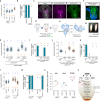The steroid-hormone ecdysone coordinates parallel pupariation neuromotor and morphogenetic subprograms via epidermis-to-neuron Dilp8-Lgr3 signal induction
- PMID: 34099654
- PMCID: PMC8184853
- DOI: 10.1038/s41467-021-23218-5
The steroid-hormone ecdysone coordinates parallel pupariation neuromotor and morphogenetic subprograms via epidermis-to-neuron Dilp8-Lgr3 signal induction
Abstract
Innate behaviors consist of a succession of genetically-hardwired motor and physiological subprograms that can be coupled to drastic morphogenetic changes. How these integrative responses are orchestrated is not completely understood. Here, we provide insight into these mechanisms by studying pupariation, a multi-step innate behavior of Drosophila larvae that is critical for survival during metamorphosis. We find that the steroid-hormone ecdysone triggers parallel pupariation neuromotor and morphogenetic subprograms, which include the induction of the relaxin-peptide hormone, Dilp8, in the epidermis. Dilp8 acts on six Lgr3-positive thoracic interneurons to couple both subprograms in time and to instruct neuromotor subprogram switching during behavior. Our work reveals that interorgan feedback gates progression between subunits of an innate behavior and points to an ancestral neuromodulatory function of relaxin signaling.
Conflict of interest statement
The authors declare no competing interests.
Figures







Similar articles
-
Triggering and modulation of a complex behavior by a single peptidergic command neuron in Drosophila.Proc Natl Acad Sci U S A. 2025 Mar 18;122(11):e2420452122. doi: 10.1073/pnas.2420452122. Epub 2025 Mar 14. Proc Natl Acad Sci U S A. 2025. PMID: 40085652
-
Drosophila Lgr3 Couples Organ Growth with Maturation and Ensures Developmental Stability.Curr Biol. 2015 Oct 19;25(20):2723-9. doi: 10.1016/j.cub.2015.09.020. Epub 2015 Oct 1. Curr Biol. 2015. PMID: 26441350
-
Dilp8 requires the neuronal relaxin receptor Lgr3 to couple growth to developmental timing.Nat Commun. 2015 Oct 29;6:8732. doi: 10.1038/ncomms9732. Nat Commun. 2015. PMID: 26510564 Free PMC article.
-
The biology and evolution of the Dilp8-Lgr3 pathway: A relaxin-like pathway coupling tissue growth and developmental timing control.Mech Dev. 2018 Dec;154:44-50. doi: 10.1016/j.mod.2018.04.005. Epub 2018 Apr 30. Mech Dev. 2018. PMID: 29715504 Review.
-
Timing Drosophila development through steroid hormone action.Curr Opin Genet Dev. 2024 Feb;84:102148. doi: 10.1016/j.gde.2023.102148. Epub 2024 Jan 24. Curr Opin Genet Dev. 2024. PMID: 38271845 Review.
Cited by
-
Adhesive and mechanical properties of the glue produced by 25 Drosophila species.Sci Rep. 2024 Oct 6;14(1):23249. doi: 10.1038/s41598-024-74358-9. Sci Rep. 2024. PMID: 39370426 Free PMC article.
-
Interorgan communication through peripherally derived peptide hormones in Drosophila.Fly (Austin). 2022 Dec;16(1):152-176. doi: 10.1080/19336934.2022.2061834. Fly (Austin). 2022. PMID: 35499154 Free PMC article. Review.
-
Motor dysfunction in Drosophila melanogaster as a biomarker for developmental neurotoxicity.iScience. 2022 Jun 7;25(7):104541. doi: 10.1016/j.isci.2022.104541. eCollection 2022 Jul 15. iScience. 2022. PMID: 35769875 Free PMC article.
-
Gross morphology and adhesion-associated physical properties of Drosophila larval salivary gland glue secretion.Sci Rep. 2024 Apr 29;14(1):9779. doi: 10.1038/s41598-024-57292-8. Sci Rep. 2024. PMID: 38684688 Free PMC article.
-
Triggering and modulation of a complex behavior by a single peptidergic command neuron in Drosophila.Proc Natl Acad Sci U S A. 2025 Mar 18;122(11):e2420452122. doi: 10.1073/pnas.2420452122. Epub 2025 Mar 14. Proc Natl Acad Sci U S A. 2025. PMID: 40085652
References
-
- Carew TJ. Behavioral Neurobiology: The Cellular Organization of Natural Behavior. Oxford: Oxford University Press; 2000.
-
- Cooke S. J., Crossin G. T., Hinch S. G. Pacific salmon migration: completing the cycle. In: Farrell A. P., (ed.), Encyclopedia of Fish Physiology: From Genome to Environment. 3, 1945–1952 (Academic Press, San Diego, Jun 2011).
-
- Turner SE, et al. Birth in free-ranging Macaca fuscata. Int. J. Primatol. 2010;31:15–37. doi: 10.1007/s10764-009-9376-8. - DOI
Publication types
MeSH terms
Substances
Grants and funding
LinkOut - more resources
Full Text Sources
Molecular Biology Databases
Research Materials

